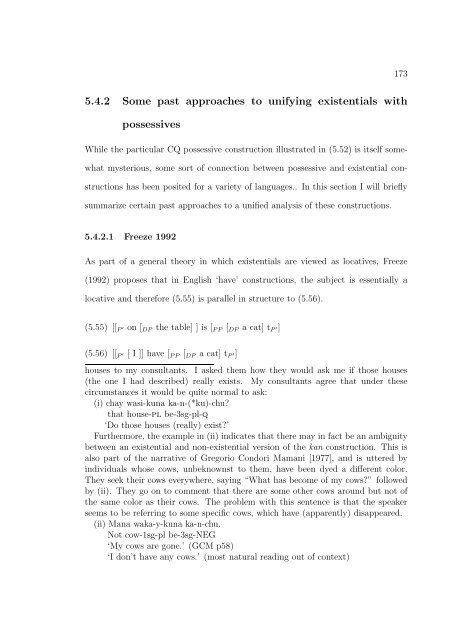the syntax and semantics of relativization and quantification
the syntax and semantics of relativization and quantification
the syntax and semantics of relativization and quantification
You also want an ePaper? Increase the reach of your titles
YUMPU automatically turns print PDFs into web optimized ePapers that Google loves.
173<br />
5.4.2 Some past approaches to unifying existentials with<br />
possessives<br />
While <strong>the</strong> particular CQ possessive construction illustrated in (5.52) is itself somewhat<br />
mysterious, some sort <strong>of</strong> connection between possessive <strong>and</strong> existential constructions<br />
has been posited for a variety <strong>of</strong> languages.. In this section I will briefly<br />
summarize certain past approaches to a unified analysis <strong>of</strong> <strong>the</strong>se constructions.<br />
5.4.2.1 Freeze 1992<br />
As part <strong>of</strong> a general <strong>the</strong>ory in which existentials are viewed as locatives, Freeze<br />
(1992) proposes that in English ‘have’ constructions, <strong>the</strong> subject is essentially a<br />
locative <strong>and</strong> <strong>the</strong>refore (5.55) is parallel in structure to (5.56).<br />
(5.55) [[ P ′ on [ DP <strong>the</strong> table] ] is [ PP [ DP a cat] t P ′]<br />
(5.56) [[ P ′ [ I ]] have [ PP [ DP a cat] t P ′]<br />
houses to my consultants. I asked <strong>the</strong>m how <strong>the</strong>y would ask me if those houses<br />
(<strong>the</strong> one I had described) really exists. My consultants agree that under <strong>the</strong>se<br />
circumstances it would be quite normal to ask:<br />
(i) chay wasi-kuna ka-n-(*ku)-chu?<br />
that house-pl be-3sg-pl-q<br />
‘Do those houses (really) exist?’<br />
Fur<strong>the</strong>rmore, <strong>the</strong> example in (ii) indicates that <strong>the</strong>re may in fact be an ambiguity<br />
between an existential <strong>and</strong> non-existential version <strong>of</strong> <strong>the</strong> kan construction. This is<br />
also part <strong>of</strong> <strong>the</strong> narrative <strong>of</strong> Gregorio Condori Mamani [1977], <strong>and</strong> is uttered by<br />
individuals whose cows, unbeknownst to <strong>the</strong>m, have been dyed a different color.<br />
They seek <strong>the</strong>ir cows everywhere, saying “What has become <strong>of</strong> my cows?” followed<br />
by (ii). They go on to comment that <strong>the</strong>re are some o<strong>the</strong>r cows around but not <strong>of</strong><br />
<strong>the</strong> same color as <strong>the</strong>ir cows. The problem with this sentence is that <strong>the</strong> speaker<br />
seems to be referring to some specific cows, which have (apparently) disappeared.<br />
(ii) Mana waka-y-kuna ka-n-chu.<br />
Not cow-1sg-pl be-3sg-NEG<br />
‘My cows are gone.’ (GCM p58)<br />
‘I don’t have any cows.’ (most natural reading out <strong>of</strong> context)
















